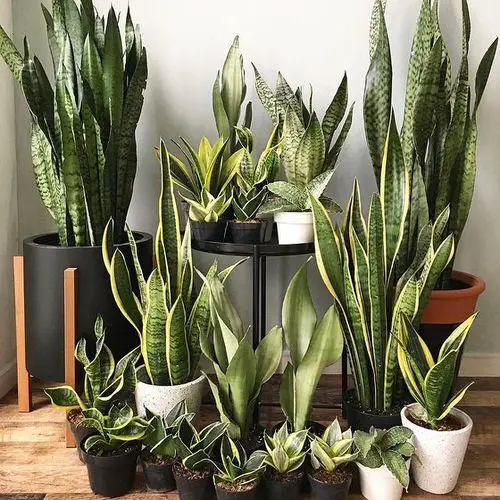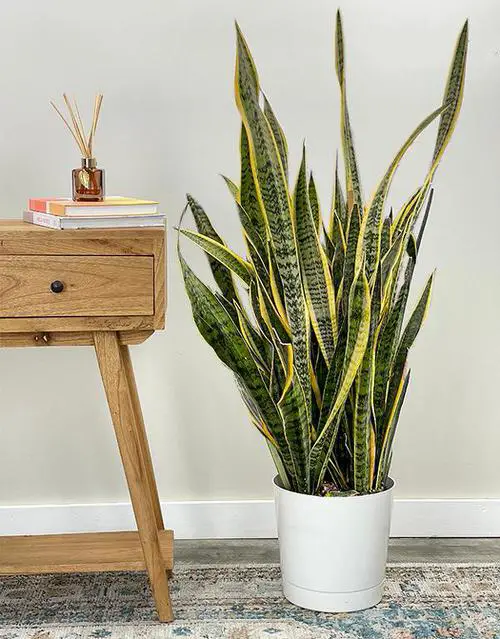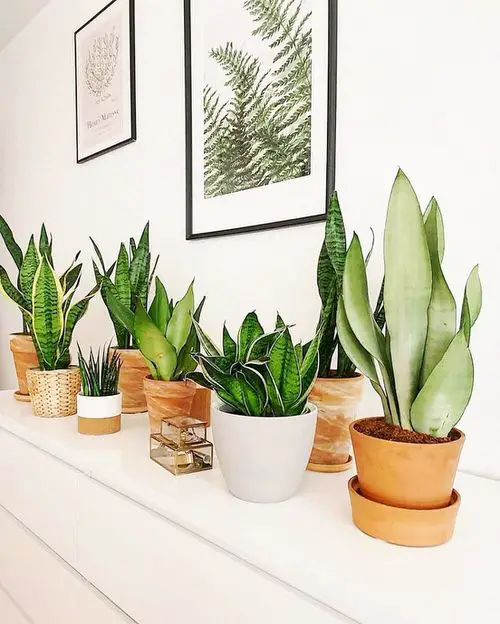Mother-in-law’s tongue is an ideal plant for clean indoor air. Learn How to Grow Snake Plant Indoors in this detailed article!

The snake plant or mother-in-law’s tongue is a desirable houseplant because of its low maintenance nature and unique appearance. It is not only popular for its looks but also holds many health benefits, including air purifying abilities.
The NASA clean air study has proved that it can remove air pollutants and VOCs like formaldehyde, benzene, toluene, and xylene from indoor air. So we have compiled all the information on How to Grow Snake Plant Indoors!
Botanical name: Sansevieria trifasciata
Other names: St. George’s sword, Mother-in-law’s tongue, Snake plant, Bowstring hemp
Here are some amazing snake plant benefits
Types of Snake Plants

There are approx 70 sansevieria species in existence. But the most popular among them is Sansevieria trifasciata, also known as the common snake plant. Some other essential sansevieria varieties are:
- Sansevieria Trifasciata’ Black Gold’: Has dark-green foliage with golden-yellow edges and grows 2-3 feet tall.
- Sansevieria Trifasciata’ Twisted Sister’: Famous for its curly leaves, It grows to a height of 1 foot.
- Sansevieria Trifasciata’ Golden Hahnii’: A dwarf variety with green striped markings, the plant grows a foot tall.
- Sansevieria Trifasciata ‘Laurentii’: Has variegated yellow and green leaves, it attains a height of 2-4 feet.
- Sansevieria Ehrenbergii ‘Banana’: Another dwarf with thick, boat-shaped leaves. The plant grows just a foot tall.
Want to discover more? Check out the best varieties of snake plants here
Choosing a Container
The leaves of the snake plant go upright and attain a long height, just like a sword. As it also grows pups around the base, it will be better to choose a wider pot than a deeper one. Selecting a container will also depend on the cultivar you have.
Any 8 to 12 inches pot will be more than sufficient for most varieties initially, but you can start dwarf varieties like Sansevieria ballyi in a smaller, 5 to 6 inches pot.
The container must have proper drainage holes to prevent root rot.
Have a look at the best dwarf snake plants here
How to Grow Snake Plant Indoors?

Growing snake plants indoors is super easy. It thrives on neglect, and if you tend to forget about your plants, sansevieria is a perfect choice.
Propagation
If you’re already growing a snake plant in your home, you can multiply it to increase the specimens. For propagating snake plants, get it done by leaf cuttings, pups, or by dividing roots.
- Go for the simplest way of propagation by removing pups that grow close to the mother plant. Remove the pups with the help of a knife and let them rest for 2-3 days. Then, pot them in well-drained soil.
- A division method is also a nifty option. You only need to remove the pups from the plant and propagate them in a wide container using well-draining potting soil.
- You also have an option to grow this from leaves, but it takes time. If you want to learn, we have a detailed article here. You can also check out our article on the best ways to propagate snake plants here.
Check out our article on growing hibiscus indoors here.
Requirements for Growing Snake Plant Indoors

The snake plant will grab the top spot if there is a ranking to select the most tolerant houseplant.
Location
Although they can tolerate full sun, keeping the plant in the shade is advisable. A spot where it can receive bright indirect sunlight is excellent. If you’re growing them near a south-facing window that gets a lot of direct sunlight, the plant will soon greet you with exotic blooms that become highly fragrant at night.
Want to learn more about snake plant blooms? Click here
You can also position them in bedrooms as they’re CAM plants. Bright bathrooms are also a lovely home for these succulents. While they can grow without direct sun, this doesn’t mean you should keep these plants in the darkest corners.
Also, exposure to a couple of hours of direct morning sun is good for snake plants.
Soil
As snake plants are prone to root rot, it is best to grow them in well-draining soil. You can also go for a succulent or cactus mix available in the market or make one for yourself with the recipes here. If you’re using a houseplant mix, add 50 percent perlite. Avoid using Vermiculite as it holds water that succulents like snake plants do not like.
If you are using regular potting soil, mix equal parts of coarse sand or perlite to make it free draining. Alternatively, you can mix equal parts of sphagnum peat moss or coco peat, perlite or coarse sand, regular potting soil, or sterilized garden soil and use the mixture as a growing medium.
Water
The key is not to overwater your snake plant for long. It is best to wait until the topsoil goes dry between watering intervals. Also, ensure to water less in winters!
You can always feel the soil moisture by poking the index finger before watering again. Also, try to keep leaves dry by avoiding overhead watering. With the snake plant growing indoors, you can easily wait 15 to 20 days before watering again.
Temperature
Snake plants do best in temperatures between 70-90 F (21-32 C). As they thrive in warmth, cold temperatures adversely affect them.
If you keep them in a warm room, protected from cold drafts in winter, they overwinter easily. They can easily withstand lower temperatures down to 41 F (5 C) and up to 104 F (40 C).
Snake Plant Care

Snake plant care is easy, as this plant doesn’t require special attention. But you should know some things, like wiping the leaves every other week with a soft wet cloth to get rid of dirt on its decorative foliage.
Fertilizer
As long as you keep the plant in an airy location that receives ample indirect, bright light, you don’t have to worry about anything. As the snake plant is succulent, it’s better to fertilize less often than feed a lot and kill it.
Fertilize your snake plant with an all-purpose liquid fertilizer like 10-10-10 once in 3 to 6 weeks when the plant is actively growing. Dilute the feed to 1/4 of its strength.
Avoid fertilization during winters in a cold climate.
Humidity
The snake plant loves humid conditions. However, if you’re keeping it in the vicinity of other plants, it’ll appreciate. If you notice dry air symptoms, turn on a humidifier near it for a few days.
Repotting
Snake plants are fast growers; therefore, repotting can be done every year or two by removing pups, growing them, or dividing them. Choose a pot that is 1 or 2 sizes larger than the previous one. The best repotting time is spring and summer.
Pest and Diseases
Mother-in-law’s tongue plant sometimes gets affected by mealybugs and spider mites. These pests suck the sap from the plant and make it fragile.
To prevent the plant from these insects, wipe off the leaves with a damp cloth or handpick them. To avoid infestation of mites, increase humidity in the atmosphere.
Have a look at the trendiest snake plants here
A Quick Look at Common Snake Plant Problems and Their Solutions
- Curling and Folding Leaves: This might be due to too much sun exposure, shrimp infestations, under or over watering, root rot, and transplant shock.
- Leaves Turning Yellow: Overwatering, low light, and harsh sun exposure are the leading causes.
- Falling Leaves: Overwatering is one of the biggest reasons.
- Brown Tips or Spots on Leaves: Use of hard water, overfertilization, and temperature change are the main reasons.
- Mushy and Soft Leaves: Sign of overwatering.
- Splitting Leaves: Physical damage or low humidity levels.
- Leaves Bending or Drooping: A sign of overwatering.
- Stunted Growth: Improper light or pest infestation.
Here are the secrets of fixing the most common snake plant problems
Toxicity
As per ASPCA, the snake plant is considered mildly toxic to humans and pets. It has Saponins, which may result in vomiting or diarrhea if ingested.



I tried propagating Snake Plant cuttings through the water method. The cuttings, each 2 inches long, were allowed to callus for a day then the cut ends were placed in water. It is over 40 days and I see no root formation. But the cuttings are fine and have not rotted. Do I have to wait longer for roots to form? How long does it normally take to root using this method? I live in the south of India it s summer time now. Pls suggest.
This plant is always in SLOW MOTION, meaning it takes a long time to grow and change. When I placed the cuttings in sandy soil they grew roots quicker. They do NOT need to be watered very often, in fact hardly at all. I live along the coast in Southern California, USA